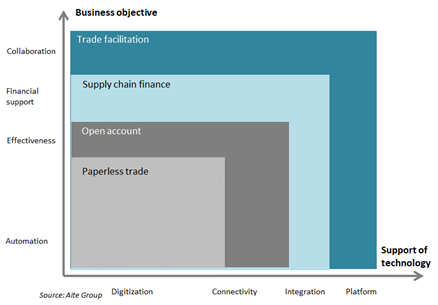The very recent news about AP Moller-Maersk and IBM eliminating TradeLens—a blockchain-based digital trade platform—has caught many by surprise as there was no evidence that the situation had worsened to this point.
While I cannot claim that I told you so, I can certainly assert that what I wrote in September 2016, Trade Facilitation and Trade Financing: Building New Bridges, and April 2019, Trade Finance Consortia: A Market Overview, both indicate what makes a digital trade platform successful, regardless of the underlying technology infrastructure (i.e., blockchain or not). Apparently, not all suggested indications were in place at TradeLens (nor at we.trade, another recently shut-down trade finance platform).
In Trade Facilitation and Trade Financing: Building New Bridges, written in collaboration with the UN/CEFACT Supply Chain Programme Development Area, you could read:
- The exclusion of financing […] as a key component of trade facilitation, misses a critical commercial reality that underpins global trade flows, trade relationships, and international supply chains.
- Explicitly integrate and include (i.e., bridge) trade finance and supply chain finance (SCF) into current frameworks and practices related to trade facilitation.
Where TradeLens Fell Short
The mission statement on the main page of TradeLens’s website reads, “Building a world of paperless trade.” There is no proposition of SCF instruments.
Trade Finance Consortia: A Market Overview showed a reference model for trade finance consortia platforms (Figure 1) and suggested a few ideas to remember:

Ideas to Remember:
- The supply chain finance cluster is the home of consortia that offer financial support to consortium participant firms by integrating them with banks.
- The trade facilitation cluster is where consortia will likely converge to provide a trade-facilitation-platform-based ecosystem that constructs collaborative business decision-making.
- Banks should not consider trade finance consortia as short-term sources of revenue streams. Time is still needed to see where the market will lead.
- Consortium supporters should be ready to contribute by building new platforms and piloting advanced cases. This will keep them in control of the timeline to get into real (and profitable) production. Until then, the consortium will not bring in significant revenue. It’s an investment.
Where TradeLens Fell Short
Since its inception, TradeLens appeared to be an inner circle for selected partners and exclusively centered on one technology foundation (i.e., Hyperledger). Actions undertaken to relax this position in the course of time did not remove the feeling of a purposedly created high entry barrier.
Far from being a (mis)fortune teller, I believe that my 2016 and 2019 predictions are holding true and set the conditions for trade finance platform success. I recommend banks, fintech players, and corporate users to still believe in the value of trade finance consortia, to not give up and adopt a collaborative and competitive approach: Cooperate to decide what technologies to adopt, what standards to develop and follow, and what business processes to cover. Compete to establish how to use and price the new infrastructure to service clients and decide what services to develop.
I am keeping a constant eye on this space, and there’s much more to come with life-cycle banking, so feel free to reach me at [email protected].

